The longevity of viscoelastic polyurethane foam bedding is a significant factor for consumers. This characteristic refers to the duration for which the product maintains its intended support and comfort properties under normal usage conditions. Understanding this aspect is crucial for making informed purchasing decisions and anticipating replacement needs.
The value proposition hinges on its capacity to provide pressure relief and spinal alignment over an extended period. Historically, advancements in material science have aimed to increase its durability, reducing the frequency of replacements and contributing to long-term cost savings. A durable sleep surface minimizes discomfort and potentially alleviates certain physical ailments associated with inadequate support.
Several factors influence the practical lifespan of this type of bedding. These include material density, usage patterns, maintenance practices, and the quality of the manufacturing process. The following sections will delve into these factors, providing a detailed analysis of how each impacts the overall performance and useful duration of the sleep product.
Extending the Usable Period
Maximizing the functional period requires proactive care and a comprehensive understanding of contributing factors. Implementing the following suggestions can significantly enhance its resilience and maintain optimal performance.
Tip 1: Select High-Density Materials: Bedding constructed with higher density foam tends to resist compression and degradation more effectively over time. Invest in products specifying a density of 4 pounds per cubic foot or greater for improved durability.
Tip 2: Utilize a Protective Cover: Employing a waterproof and breathable mattress protector safeguards against spills, stains, and dust mites. This barrier prevents premature deterioration of the foam structure caused by moisture and allergens.
Tip 3: Ensure Adequate Support: Place it on a solid, supportive foundation, such as a platform bed or a box spring in good condition. Inadequate support can lead to uneven weight distribution and accelerated wear.
Tip 4: Rotate Regularly: Rotate the bedding 180 degrees every six months to distribute wear evenly across the surface. This practice minimizes localized compression and prevents sagging in frequently used areas.
Tip 5: Maintain Proper Ventilation: Allow the bedding to air out periodically by removing bedding and opening windows. This promotes airflow and prevents the buildup of moisture, which can contribute to mold and mildew growth.
Tip 6: Avoid Direct Sunlight: Exposure to direct sunlight can degrade the foam structure and cause discoloration. Keep it out of direct sunlight to preserve its integrity.
Tip 7: Follow Manufacturer’s Instructions: Adhere to the manufacturer’s care and maintenance guidelines for optimal performance and longevity. These instructions often provide specific recommendations for cleaning and handling.
By implementing these strategies, consumers can significantly extend the usability, ensuring a more comfortable and supportive sleep surface for an extended duration. This proactive approach not only enhances the immediate sleep experience but also provides long-term cost savings by delaying the need for replacement.
The following section will explore the indicators that suggest replacement is necessary, allowing consumers to make informed decisions about their sleep environment.
1. Material Density
Material density, measured in pounds per cubic foot (lbs/ft), exerts a direct influence on the lifespan of viscoelastic polyurethane foam bedding. It is a fundamental determinant of its durability and resistance to degradation. Higher density indicates a greater amount of material packed into a given volume, resulting in a more robust cellular structure. This enhanced structure provides superior support and a reduced susceptibility to permanent compression over time. For instance, a product with a density of 5 lbs/ft will typically exhibit greater longevity compared to a similar product with a density of 3 lbs/ft, assuming all other factors are equal. The increased material resists deformation and maintains its intended shape and support characteristics for a longer duration.
The implications of selecting a low-density product manifest in accelerated wear and tear. With repeated use, the cellular structure of low-density foam breaks down more readily, leading to sagging and a loss of support. This not only diminishes the comfort provided but also reduces its effective lifespan, necessitating more frequent replacements. Conversely, investing in higher density foam offers a tangible return in the form of extended usability and sustained performance. The higher density materials resist the compressive forces exerted during sleep, preserving their integrity and extending the interval between replacements. Real-world examples demonstrate that those who prioritize material density often report greater satisfaction with the long-term performance and reduced overall costs associated with sleep surface maintenance.
In summary, material density serves as a critical indicator of expected lifespan. Choosing a product with a higher density is generally advisable, as it translates to improved durability, sustained support, and a prolonged functional period. While other factors such as usage patterns and maintenance contribute, density forms the foundation upon which its longevity is built. Understanding this connection empowers consumers to make informed decisions, balancing initial cost with long-term value and ensuring a more satisfactory sleep experience over the duration of the product’s use.
2. Usage Frequency
The frequency with which viscoelastic polyurethane foam bedding is utilized directly influences its expected lifespan. High usage rates accelerate material fatigue and compression, thereby shortening the period of optimal performance. The correlation between usage frequency and longevity is a crucial consideration for both manufacturers and consumers.
- Daily Occupancy
Bedding used daily experiences greater wear than those used intermittently. Continuous compression from body weight and movement causes a gradual breakdown of the foam’s cellular structure. For example, a guest bedroom mattress used a few times a year will likely outlast a master bedroom mattress subjected to nightly use.
- Multiple Occupants
Products supporting multiple occupants endure significantly more stress compared to those used by a single individual. The increased weight and movement exacerbate compression and accelerate the degradation process. A couple sharing bedding will likely observe a reduction in lifespan compared to a single occupant using the same product.
- Activit
y Levels During SleepIndividuals with restless sleep patterns, characterized by frequent tossing and turning, impart greater stress on the bedding material. This increased activity contributes to localized wear and compression, reducing its overall longevity. Active sleepers may experience a decline in support and comfort more rapidly.
- Suitability for Intended Use
Employing a product intended for occasional use as a primary sleep surface will invariably shorten its lifespan. Bedding designed for infrequent occupancy typically lacks the density and structural integrity necessary to withstand continuous use. Overloading a product beyond its intended capacity diminishes its performance and accelerates the need for replacement.
In summation, usage frequency stands as a key determinant of viscoelastic polyurethane foam bedding lifespan. High rates of utilization, particularly when compounded by factors such as multiple occupants or restless sleep, expedite the degradation process. Choosing a product appropriately rated for the intended level of use and implementing measures to mitigate stress, such as regular rotation, can help to extend its functional period.
3. Support System
The support system beneath viscoelastic polyurethane foam bedding exerts a significant influence on its longevity and performance. The fundamental role of this system is to provide a stable and level surface, distributing weight evenly and preventing undue stress on the foam layers. An inadequate support system can lead to localized compression, sagging, and premature degradation of the foam, significantly shortening its useful life. For example, placing it directly on the floor, or on a bed frame with widely spaced slats, results in uneven weight distribution, concentrating pressure on specific areas and accelerating wear. Conversely, a solid platform or a box spring in good condition provides uniform support, minimizing stress concentrations and extending the lifespan.
The type of support system must also be compatible with the specific characteristics of the viscoelastic foam. A foundation that is too rigid may not allow for adequate compression and contouring, reducing comfort and potentially causing the foam to break down over time. Conversely, a foundation that is too soft may not provide sufficient support, leading to excessive sagging and a loss of its intended shape. The ideal support system complements the foam’s properties, allowing it to perform optimally while minimizing stress and maximizing durability. Real-world applications demonstrate that individuals who invest in a high-quality, compatible support system often experience a longer and more comfortable sleep surface compared to those who neglect this aspect.
In summary, the support system constitutes a critical component affecting its lifespan. It influences weight distribution, prevents premature degradation, and contributes to overall comfort. Selecting a support system that provides a stable, level, and compatible foundation is essential for maximizing the performance and extending the usable period. Neglecting the importance of this factor can lead to reduced comfort, accelerated wear, and the need for more frequent replacements, ultimately diminishing the value and benefits derived from the viscoelastic polyurethane foam bedding.
4. Maintenance Practices
Effective maintenance practices are integral to maximizing the usable period of viscoelastic polyurethane foam bedding. Consistent and appropriate care significantly mitigates wear and degradation, thereby prolonging its intended function and comfort. Neglecting these practices accelerates the breakdown of the material, reducing its lifespan and negating its inherent benefits.
- Regular Vacuuming
Vacuuming removes dust mites, allergens, and surface debris that can accumulate within the foam structure. These particles contribute to material breakdown and can exacerbate allergies. Utilizing an upholstery attachment, consumers should vacuum monthly to maintain cleanliness and prevent the accumulation of contaminants that compromise its integrity.
- Prompt Spill Management
Fluid spills, if left unattended, can penetrate the foam, fostering mold and mildew growth, and compromising the cellular structure. Immediate blotting with a clean, absorbent cloth minimizes fluid absorption. Subsequent application of a mild cleaning solution, followed by thorough drying, prevents permanent staining and material degradation caused by prolonged moisture exposure.
- Protective Cover Utilization
A waterproof and breathable mattress protector serves as a barrier against spills, stains, dust mites, and allergens. This preventative measure safeguards the foam from direct exposure to contaminants and moisture, significantly reducing the rate of deterioration. Investment in a high-quality protector represents a proactive step in extending its usability.
- Periodic Rotation and Flipping
Rotating the bedding 180 degrees every six months ensures even weight distribution across the surface, mitigating localized compression and preventing sagging. While some models are not designed to be flipped, those that are benefit from periodic flipping to distribute wear evenly. This practice promotes uniform support and extends the overall functional period.
In summation, consistent adherence to these maintenance practices plays a pivotal role in preserving the structural integrity and extending the lifespan of viscoelastic polyurethane foam bedding. Proactive care, encompassing regular cleaning, spill management, protective measures, and periodic adjustments, represents a sound investment in the long-term performance and value of the product.
5. Environmental Factors
Environmental conditions exert a considerable influence on the lifespan and performance characteristics of viscoelastic polyurethane foam bedding. Temperature, humidity, and exposure to light and pollutants can each contribute to the degradation of the material, affecting its overall longevity.
- Temperature Fluctuations
Extreme temperature variations can accelerate the breakdown of the foam’s cellular structure. High temperatures soften the material, making it more susceptible to compression and deformation, while low temperatures can cause it to become brittle and prone to cracking. Maintaining a stable and moderate temperature environment is crucial for preserving its integrity. For example, consistently storing it in an unheated or uncooled storage unit can significantly reduce its lifespan.
- Humidity Levels
Elevated humidity promotes the growth of mold and mildew within the foam, leading to material degradation and potential health hazards. Moisture absorption weakens the foam’s structure, causing it to lose its support and resilience. Conversely, excessively dry environments can cause the foam to become brittle and prone to cracking. Maintaining optimal humidity levels through proper ventilation and the use of dehumidifiers or humidifiers, as needed, is essential for preserving its
condition. - Light Exposure
Prolonged exposure to direct sunlight or other sources of ultraviolet (UV) radiation can cause the foam to discolor and degrade. UV radiation breaks down the chemical bonds within the foam, leading to a loss of elasticity and support. Shielding from direct sunlight, such as through the use of window coverings or protective sheets, minimizes this degradation and extends its lifespan. Products stored near windows without UV protection often exhibit premature deterioration.
- Air Quality and Pollutants
Exposure to airborne pollutants, such as dust, smoke, and volatile organic compounds (VOCs), can accelerate the deterioration of the foam. These pollutants can accumulate within the foam’s structure, contributing to material breakdown and potentially releasing harmful chemicals into the sleeping environment. Regular cleaning and the use of air purifiers can help mitigate the impact of these pollutants, prolonging its usability.
In conclusion, careful management of environmental factors is critical for optimizing the longevity and maintaining the quality of viscoelastic polyurethane foam bedding. Controlling temperature, humidity, light exposure, and air quality significantly minimizes material degradation and preserves the integrity, ensuring a prolonged and comfortable sleep experience.
6. Body Weight
Body weight exerts a direct and quantifiable impact on the lifespan of viscoelastic polyurethane foam bedding. Greater mass concentrated over a given area generates increased compressive force, accelerating material fatigue and structural degradation. This relationship is fundamental in understanding the factors influencing the durability and longevity of this type of sleep surface. A higher body mass index (BMI) correlates with a reduced lifespan, assuming all other variables, such as material density and maintenance practices, remain constant. The excess weight compresses the foam cells more aggressively, leading to a faster breakdown of the material’s internal structure and a subsequent loss of support. This effect is particularly pronounced in areas of concentrated pressure, such as the hips and shoulders. For example, a person weighing 250 pounds will likely experience a more rapid decline in support and comfort compared to someone weighing 150 pounds using the same product under identical conditions.
The impact of body weight is further amplified by sleep position and movement patterns. Individuals who consistently sleep in the same position or who exhibit restless sleep patterns tend to concentrate pressure on specific areas, exacerbating wear and tear. This localized compression can lead to sagging and indentations, further compromising the bedding’s ability to provide adequate support. Selection of an appropriate material density, in conjunction with a suitable support system, can mitigate the effects of body weight. Higher-density foams, coupled with a solid and level foundation, distribute weight more evenly and resist compression more effectively. Furthermore, regular rotation of the bedding can help to equalize wear across the surface, minimizing the development of localized indentations and prolonging its usable life. Real-world data indicates that individuals with higher body weights who actively manage these factors report greater satisfaction with the long-term performance and durability of their viscoelastic polyurethane foam bedding.
In summary, body weight represents a critical determinant of lifespan. Increased mass leads to accelerated material fatigue, necessitating careful consideration of material density, support system, and maintenance practices. Understanding this connection allows consumers to make informed purchasing decisions and implement strategies to mitigate the effects of body weight, thereby maximizing the value and longevity of their viscoelastic polyurethane foam bedding. Neglecting this factor can result in premature degradation, reduced comfort, and the need for more frequent replacements, ultimately increasing the overall cost of ownership.
7. Manufacturing Quality
The degree to which viscoelastic polyurethane foam bedding is well-constructed directly determines its resilience and longevity. Variations in production standards significantly influence the material’s ability to withstand prolonged use, thereby affecting its lifespan. Superior manufacturing practices result in a more durable and supportive product, while substandard practices lead to premature degradation and diminished performance.
- Foam Density Consistency
Uniform foam density throughout the entire product is crucial. Inconsistent density, resulting from inadequate mixing or substandard pouring techniques, creates weak points susceptible to compression and collapse. High-quality manufacturing ensures even distribution of materials, yielding a more resilient and longer-lasting sleep surface. Instances of inconsistent density often manifest as localized sagging and reduced support in specific areas.
- Adhesive Integrity
Adhesives bond layers of foam together in multi-layered designs. Poorly applied or inferior adhesives result in delamination, where layers separate, compromising structural integrity and comfort. Reputable manufacturers employ high-strength, durable adhesives and rigorous bonding processes to ensure lasting cohesion between layers. Delamination leads to uneven surfaces and reduced support, ultimately shortening its lifespan.
- Cover Material and Stitching
The quality of the cover material and stitching contributes to the bedding’s resistance to wear and tear. Substandard materials are prone to ripping, tearing, and pilling, exposing the foam to damage and reducing its structural integrity. Reinforced stitching and durable, high-quality fabrics protect the foam, extending its usability. Premature failure of the cover compromises the entire product’s structural integrity.
- Curing and Off-Gassing Processes
Proper curing and off-gassing processes are essential for removing residual chemicals and stabilizing the foam structure. Inadequate curing results in lingering odors and potential health hazards, while incomplete stabilization leads to premature breakdown. Reputable manufacturers invest in controlled curing environments and thorough off-gassing procedures to ensure product safety and longevity. Failure to adequately cure and off-gas the materials decreases the usefulness and comfort it offers.
These elements of manufacturing quality collectively determine the practical period. A product manufactured with consistent density, strong adhesives, durable cover materials, and proper curing processes will invariably outlast a product produced with substandard techniques. Scrutinizing manufacturing details is essential for making informed purchasing decisions and maximizing the value derived from viscoelastic polyurethane foam bedding.
Frequently Asked Questions
The following questions address common inquiries regarding the factors influencing the usable period of viscoelastic polyurethane foam bedding. These answers provide insights to aid in informed purchase decisions and maintenance practices.
Question 1: What is the typical duration of viscoelastic polyurethane foam bedding under normal usage conditions?
The average lifespan
is approximately seven to ten years. However, this duration varies significantly based on factors such as material density, usage frequency, maintenance practices, and support system quality.
Question 2: How does material density impact the longevity of the product?
Higher density materials exhibit greater resistance to compression and degradation, resulting in a longer functional period. Investing in a product with a density of 4 pounds per cubic foot or greater is advisable for extended durability.
Question 3: What role does the support system play in extending its lifespan?
A solid and level support system, such as a platform bed or a box spring in good condition, ensures even weight distribution, preventing localized compression and premature wear. Inadequate support shortens its lifespan.
Question 4: What maintenance practices contribute to extending the functional period?
Regular vacuuming, prompt spill management, the use of a protective cover, and periodic rotation are essential maintenance practices. These measures mitigate wear and degradation, prolonging its intended function and comfort.
Question 5: How does body weight influence its lifespan?
Increased body weight exerts greater compressive force on the foam, accelerating material fatigue and structural degradation. Individuals with higher body weights should consider selecting higher density materials and ensuring adequate support.
Question 6: What are the key indicators that replacement is necessary?
Persistent sagging, visible indentations, a noticeable loss of support, and increased discomfort during sleep indicate that replacement may be necessary. These signs suggest the material has reached the end of its functional life.
In summation, understanding the interplay of factors such as material density, support system, usage patterns, and maintenance practices is crucial for maximizing its longevity and maintaining optimal sleep quality.
The subsequent section will provide guidance on evaluating the overall value proposition, considering both initial cost and expected lifespan.
Conclusion
The preceding analysis has elucidated the multifaceted aspects that determine the “life of memory foam mattress.” Material density, usage frequency, support mechanisms, maintenance protocols, environmental influences, body weight, and manufacturing quality each exert a definitive influence on its usable duration. A comprehensive understanding of these factors is paramount for consumers seeking to optimize their investment.
Prudent evaluation of these determinants, coupled with proactive maintenance, can extend the functional period and ensure sustained sleep quality. Conversely, neglecting these considerations leads to premature degradation and diminished value. Responsible stewardship of this bedding represents a sound economic decision and a commitment to long-term well-being.


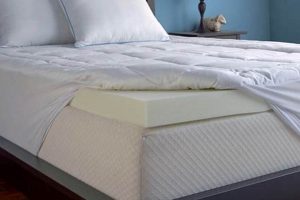
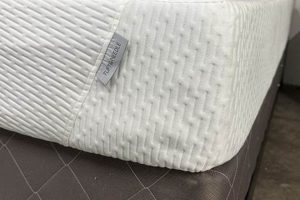
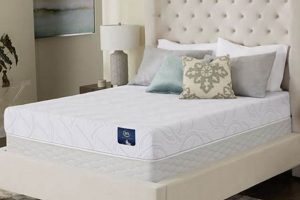
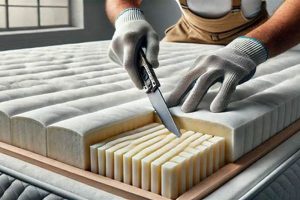
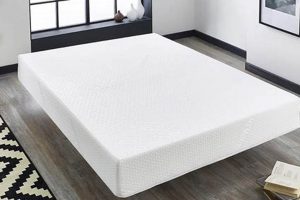
![Best Memory Foam Mattress Queen Walmart [Deals!] Organic & Natural Mattress Buyer’s Guide: Non-Toxic Sleep Solutions Best Memory Foam Mattress Queen Walmart [Deals!] | Organic & Natural Mattress Buyer’s Guide: Non-Toxic Sleep Solutions](https://mattressworldpa.com/wp-content/uploads/2025/07/th-3980-300x200.jpg)